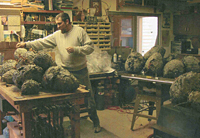The Bugman of Westby
The Bugman of Westby

You might call it bug d'art, and Jim Greenwell's Westby office is positively crammed with it.
Greenwell, a sculptor who moonlights as the full-time studio technician for Rowan's Art Department, finds inspiration in subjects that cause most people agitation, palpitation and, let's face it, perspiration.
To him, there's beauty in coarse-haired crickets' legs, comeliness in caterpillars, handsomeness in hornets' nests.
It may be a bug-eat-bug world but during his short time on their planet Greenwell is doing all he can to document the insect. And loving every minute of it.
"I've had a fascination with them for at least 10 years," said Greenwell, a former professional cabinetmaker who now crafts bugs, bug parts, tables, lamps and other insect-inspired pieces out of a vast palette of materials - wood, glass, metal, clay, rubber, latex, even chitin (pronounced kai-tin), the main component in bug bodies.
In fact, it was his introduction to chitin that first drew his attention to insects.
"They're completely made of it," Greenwell said. "Their shells, their organs, their eyes, everything."
He described chitin, which is also a major component of shrimp, lobster and crab shells, as "almost the missing link," a naturally occurring polymer with myriad commercial and medical uses.
Greenwell, who once produced a gallery-quality female form completely from shrimp shells, is driven by a fascination with materials like chitin and rare woods and how he can manipulate them almost at will.
And the pieces in his office reflect this. There's a table made from spalted wood - partially rotted, kiln-dried and carved; "flea legs" shaped from wire and nylon stocking; a three-foot tall "cricket leg" lamp, and much more.
"I was working in the studio one night when I saw a cricket eating an egg and that was my inspiration," he explained of the piece. "That is what the leg of a cricket holding an egg looks like under 20x magnification."
The main "leg" portion of the work is made of East Indian rosewood and oriented strandboard, a material produced from crushed tree splinters and glue. He crafted the "egg" from Fiberglas and fitted it with a long narrow light tube.
Greenwell said most young sculptors assume their palette is limited to common hardwoods, metals and clays, and he finds joy instructing otherwise.
"One of the most exciting things about this job is sharing all this information," he said. "Most students don't have a clue you can use all these different materials for art."
Perhaps his most unusual use of materials was paper collected from some 50 dead hornets' nests some years back. He and his daughter harvested the nests - which were teaming with insects a few weeks before - after the first frost when all the bugs were dead. Greenwell pulped the gray paper from the nests and constructed a replica of his own house.
Greenwell, a lab technician at Rowan for 16 years, has shown his work in at least 50 exhibits, most at college campuses around New Jersey and in area galleries. A recent exhibit at Camden County College in Blackwood featured his handcrafted ceramics work.
"One piece was a full-sized radiator with a bug smashed in it," he said. "Another was a moth-covered window sill. Then there was this third piece, the back seat of a Volkswagen with a big dead hornet. Everything, from the seat to the hornet, was made from clay."
Fine Art major Amy Leach, 22, of Mantua, said Greenwell's guidance with equipment and materials has been a big help in producing her own work.
"He's experimented with a lot so he'll suggest construction materials and it's very useful," she said.
As for his work?
"I find it fascinating," Leach said. "Insects normally creep me out but he finds beauty in them that's interesting and different."